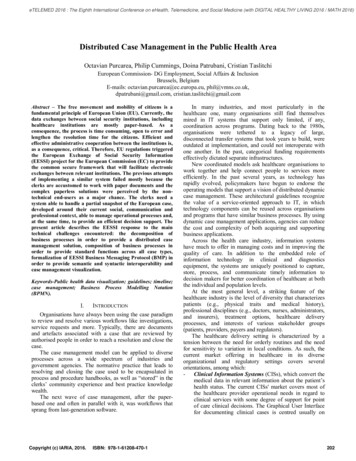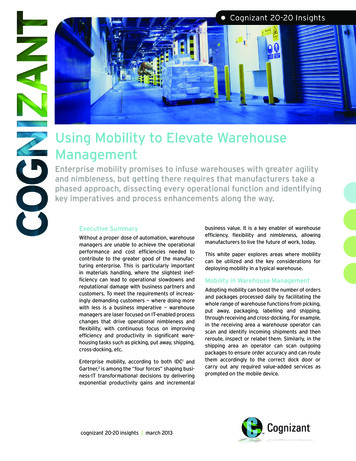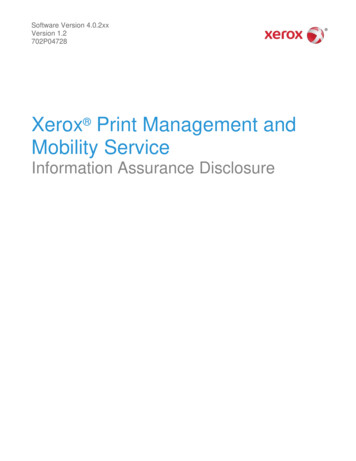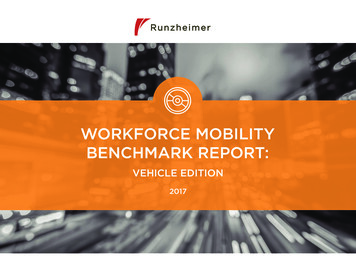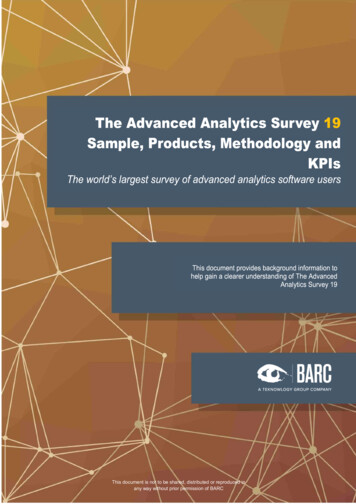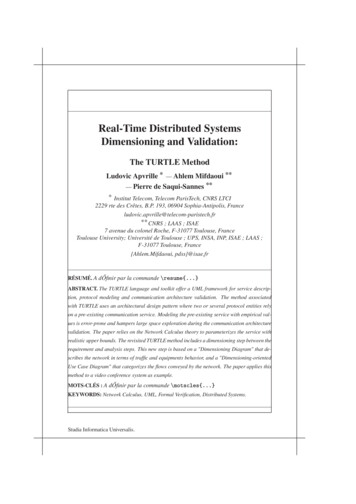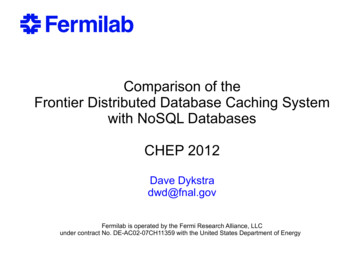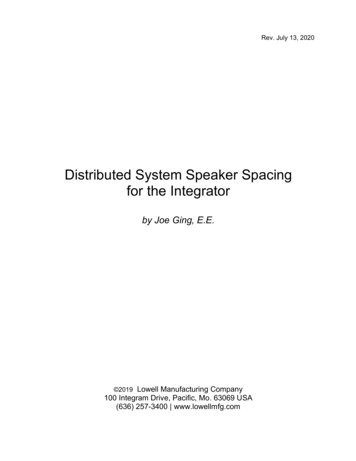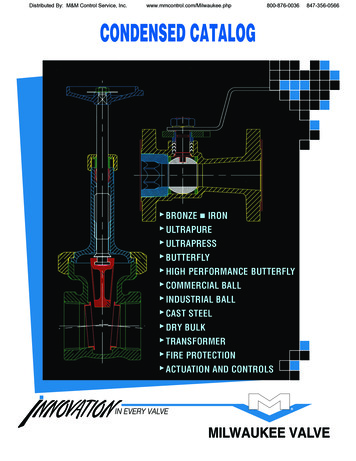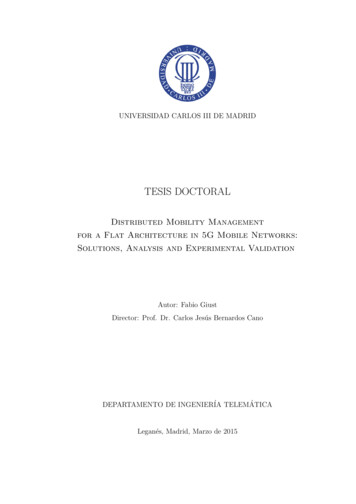
Transcription
UNIVERSIDAD CARLOS III DE MADRIDTESIS DOCTORALDistributed Mobility Managementfor a Flat Architecture in 5G Mobile Networks:Solutions, Analysis and Experimental ValidationAutor: Fabio GiustDirector: Prof. Dr. Carlos Jesús Bernardos CanoDEPARTAMENTO DE INGENIERÍA TELEMÁTICALeganés, Madrid, Marzo de 2015
Distributed Mobility Management for a Flat Architecture in 5G Mobile Networks:Solutions, Analysis and Experimental ValidationA dissertation submitted in partial fulfilment of the requirements for the degree ofDoctor of PhilosophyPrepared byFabio GiustUnder the advice ofProf. Dr. Carlos Jesús Bernardos CanoDate: March 2015Departamento de Ingenierı́a Telemática, Universidad Carlos III de MadridThis work has been partially supported by IMDEA Networks Institute.
TESIS DOCTORALDistributed Mobility Managementfor a Flat Architecture in 5G Mobile Networks:Solutions, Analysis and Experimental ValidationAutor: Fabio GiustDirector: Prof. Dr. Carlos Jesús Bernardos CanoFirma del tribunal ficación:Leganés,dede
AcknowledgementsThis PhD thesis is the result of a four years work with my advisor Carlos Jesús, towhom I address my most profound gratitude for all he could transmit and the gratificationshe gave me throughout this period. Then, I would like to thank his colleague Antonio DeLa Oliva for the extensive collaboration that the three of us had (and hopefully will havein the future) to achieve this result.I would like also to thank the IMDEA Networks Institute and its directors duringthese years, Arturo Azcorra and Albert Banchs, for supporting this thesis.Besides, a special thanks goes to the people at UC3M and at IMDEA with whom Ispent most of the time and shared all the Spanish adventures: Isabel and José Pablo forthe long term friendship (and co-housing), Camilo, Ignacio, Marco, Andrés, Andra, Luca,Iñaki, Pablo, Gregorio, Goyo, Alberto and all who passed through LAB 4.1C01.Then, I would like to mention Telemaco for encouraging me to start my PhD, and theIntegration Team guys of the MEDIEVAL project, Daniele, Gerald, Bessem, Loris, Rui,Philippe, Sérgio and Alberto.I thank my parents, Aurelia and Renzo, who have always accepted all my decisionswithout posing any objection.Un saluto agli amici della sinistra Piave che non ho mai smesso di sentire presentinonostante i molti Km di lontananza, Lupin, Wally, Pichichi, Bubu, Elisa, Eva, Alberto,Della, Riki, Ale, Martyn e il Nonno.Finally, I would like to thank you, Chiara, for having always supported me with yourprecious love and trust and, of course, for keeping me rockin’ in a free world!i
ResumenEl despliegue comercial de los servicios de datos en las redes móviles ha evolucionadorápidamente en los últimos años, proporcionando tecnologı́as de acceso radio más avanzadas y arquitecturas de red más eficientes. Los usuarios ya pueden disfrutar de losservicios de banda ancha desde sus dispositivos móviles, como smartphones y tablets,aprovechando la conectividad de las modernas redes 4G. Sin embargo, la evolución tecnológica sigue trazando su camino hasta el desarrollo de las redes de próxima generación,o 5G, en previsión del enorme aumento del tráfico de los años futuros.Una de las innovaciones bajo estudio aborda la arquitectura de las redes móviles, conel objetivo de diseñar un sistema plano. Efectivamente, el sistema actual se basa en unaestructura centralizada y jerárquica, en la cual múltiples redes de acceso se conectan alnúcleo central, dónde residen funciones cruciales para el control de la red y facturación,ası́ como la gestión de la movilidad, que es el tema central de esta tesis. En un sistemacon gestión centralizada de la movilidad, se agregan los flujos de tráfico en algunos nodosclaves situados en el núcleo de la red, llamados anclas de movilidad. De este modo, unancla puede fácilmente redirigir los flujos al lugar donde se halla el usuario, pero i) suponeproblemas de escabilidad, ii) representa un punto único de fallo, y iii) el encaminamientoes en general sub-óptimo. Estos problemas se pueden resolver pasando a una arquitecturaplana, cambiándose a un sistema de gestión distribuida de la movilidad (DistributedMobility Management – DMM), donde no hay anclas centralizadas.Esta tesis se desarrolla dentro el marco propuesto por DMM, presentando el diseño, elanálisis, la implementación y la validación experimental de varios protocolos de movilidaddistribuida. Se describen soluciones basadas en el cliente y en la red, ası́ como unasolución hı́brida. El funcionamiento de las soluciones ha sido estudiado analı́ticamente,para evaluar los costes de señalización, el coste del transporte de los paquetes y la latenciapara gestionar el traspaso de los usuarios de una red a otra. Finalmente, la validez de losprotocolos ha sido demostrada con experimentos sobre un prototipo donde se implementanalgunas de las soluciones utilizando el equipamiento de nuestro laboratorio.Palabras claves.Gestión de la movilidad centralizada y distribuida, protocolos demovilidad, redes móviles y inalámbricas, redes IP, evaluación analı́tica y experimental.iii
AbstractIn the last years, the commercial deployment of data services in mobile networks hasbeen evolving quickly, providing enhanced radio access technologies and more efficientnetwork architectures. Nowadays, mobile users enjoy broadband and ubiquitous wirelessaccess through their portable devices, like smartphones and tablets, exploiting the connectivity offered by the modern 4G network. Nevertheless, the technological evolutionkeeps moving towards the development of next generation networks, or 5G, aiming atfurther improving the current system in order to cope with the huge data traffic growthforeseen in the future years.One of the possible research guidelines aims at innovating the mobile networks architecture by designing a flat system. Indeed, current systems are built upon a centralizedand hierarchical structure, where multiple access networks are connected to a centralcore hosting crucial network functions, e.g., charging, control and maintenance, as well asmobility management, which is the main topic of this thesis. In such a central mobilitymanagement system, users’ traffic is aggregated at some key nodes in the core, calledmobility anchors. Thus, an anchor can easily handle user’s mobility by redirecting traffic flows to his/her location, but i) it poses scalability issues, ii) it represents a singlepoint of failure, and iii) the routing path is in general suboptimal. These problems canbe overcome moving to a flat architecture, adopting a Distributed Mobility Management(DMM) system, where the centralized anchor is removed.This thesis develops within the DMM framework, presenting the design, analysis,implementation and experimental validation of several DMM protocols. In this work wedescribe original protocols for client-based and network-based mobility management, aswell as a hybrid solution. We study analytically our solutions to evaluate their signallingcost, the packet delivery cost, and the latency introduced to handle a handover event.Finally, we assess the validity of some of our protocols with experiments run over a networkprototype built in our lab implementing such solutions.Key words.Centralized and Distributed Mobility Management, mobility protocols,mobile and wireless networks, IP networks, analytic and experimental evaluation.v
List of Abbreviations3G, 4G, 5G3rd , 4th , 5th Generation Mobile Networks3GPP, 3GPP2 3rd Generation Partnership Project, –2AAAgent AdvertisementAAAAuthentication, Authorization and AccountingAPAccess PointARPAddress Resolution ProtocolASAgent SolicitationATTAccess Technology TypeBABinding AcknowledgmentBCBinding CacheBCEBinding Cache EntryBGPBorder Gateway ProtocolBSCBase Station ControllerBUBinding UpdateBULBinding Update ListBULEBinding Update List EntryC-DMMClient-based DMMCDNContent Delivery NetworkCGACryptographically Generated AddressCKTCoA Keygen TokenCMConnection ManagerCMDCentral Mobility DatabaseCNCorrespondent NodeCoACare-of Addressvii
viiiCoTCare-of TestCoTICare-of Test InitializationDADDuplicate Address DetectionDASHDynamic Adaptive Streaming over HTTPDLDownlinkDMMDistributed Mobility ManagementDMM-GWDMM GatewayDNSDomain Name SystemDPIDeep Packet InspectionDSMIPv6Dual-Stack Mobile IPv6EDGEEnhanced Data rates for GSM EvolutioneNBevolved NodeBEPCEvolved Packet CoreEPSEvolved Packet SystemeUTRANevolved UMTS Terrestrial Radio Access NetworkFAForeign AgentFHRPFlow Handover ReplyFHRQFlow Handover RequestFMFlow ManagerGERANGSM EDGE Radio Access NewtorkGGSNGateway GPRS Support NodeGPRSGeneral Packet Radio ServiceGTPGPRS Tunneling ProtocolHAHome AgentH-DMMHybrid DMMHeNBHome eNodeBHIHandoff IndicatorHMIPv6Hierarchical Mobile IPv6HNPHome Network PrefixHOHandover or Handoff
ixHoAHome AddressHSPAHigh Speed Packet AccessHTTPHyperText Transfer ProtocolIANAThe Internet Assigned Numbers AuthorityIEEEThe Institute of Electrical and Electronics EngineersIETFThe Internet Engineering Task ForceIMSIP Multimedia SubsystemIP, IPv4, IPv6 Internet Protocol, IP version 4, IP version 6ISPInternet Service ProviderIPsecInternet Protocol SecurityIXPInternet eXchange PointLANLocal Area NetworkLMALocal Mobility AnchorLMDLocalized Mobility DomainLANPLocally Anchored Network PrefixLTELong Term EvolutionMACMedium Access ControlMAGMobile Access GatewaymCDNmobile CDNMHMobility HeaderMIHMedia Independent HandoverMIHSMedia Independent Handover ServicesMIISMedia Independent Information ServiceMIPv4Mobile IPv4MIPv6Mobile IPv6MMEMobility Management EntityMNMobile NodeMN-IDMobile Node IdentifierMNOMobile Network OperatorNATNetwork Address TranslationNDNeighbor Discovery
xN-DMMNetwork-based DMMNetLMMNetwork-based Localized Mobility ManagementNFVNetwork Functions VirtualizationODMMOpen platform for DMM solutionsPBAProxy Binding AcknowledgmentPBUProxy Binding UpdateP-CoAProxy Care-of AddressPDNPacket Data NetworkPDPPacket Data ProtocolPGWPDN GatewayPHKTPermanent HoA Keygen TokenPMIPv6Proxy Mobile IPv6PoAPoint of AccessPoCProof of ConceptPoSPoint of ServicePPPPoint-to-Point ProtocolQoEQuality of ExperienceQoSQuality of ServiceRARouter AdvertisementRADIUSRemote Authentication Dial In User ServiceRANRadio Access NetworkRDRouter DiscoveryRFCRequest For CommentsRNCRadio Network ControllerRORoute OptimizationRRReturn RoutabilityRSRouter SolicitationRTTRound Trip TimeSAESystem Architecture EvolutionSDNSoftware Defined Networking
xiSGSNServing GPRS Support NodeSGWServing GatewaySLAACStateLess Address Auto-ConfigurationTCPTransport Control ProtocolUEUser EquipmentUDPUser Datagram ProtocolULUplinkUMTSUniversal Mobile Telecommunications SystemUTRANUMTS Terrestrial Radio Access NetworkVoIPVoice over IPVoLTEVoice over LTEWCDMAWideband Code Division Multiple AccessWiFiIEEE 802.11 WLANWiMAXWorldwide Interoperability for Microwave AccessWLANWireless LAN
ContentsAcknowledgementsiResumeniiiAbstractvList of AbbreviationsviiContentsxiiiList of FiguresxviiList of Tablesxix1 Introduction1I7Current solutions and technologies for mobile networks2 Background on mobility protocols and mobile networks2.1Mobility in IP networks . . . . . . . . . . . . . . . . . . . . . . . . . . . .992.1.1Mobile IPv6 . . . . . . . . . . . . . . . . . . . . . . . . . . . . . . .112.1.2Proxy Mobile IPv6 . . . . . . . . . . . . . . . . . . . . . . . . . . .153GPP architectures for mobile networks . . . . . . . . . . . . . . . . . . .182.2.1The Evolved Packet System . . . . . . . . . . . . . . . . . . . . . .212.3IEEE 802.21 Media Independent Handover Services . . . . . . . . . . . . .252.4Final remarks. The need of Distributed Mobility Management . . . . . . .282.23 Related work on Distributed Mobility Management313.1Architecture dependent solutions . . . . . . . . . . . . . . . . . . . . . . .323.2Extension to existing protocols . . . . . . . . . . . . . . . . . . . . . . . .333.3Peer-to-peer solutions . . . . . . . . . . . . . . . . . . . . . . . . . . . . .363.4Clean slate proposals . . . . . . . . . . . . . . . . . . . . . . . . . . . . . .37xiii
xivCONTENTS3.5IIFinal remarks . . . . . . . . . . . . . . . . . . . . . . . . . . . . . . . . . .Distributed Mobility Management solutions4 Client-based DMM solution4143454.1Solution Overview . . . . . . . . . . . . . . . . . . . . . . . . . . . . . . .454.2Protocol Description . . . . . . . . . . . . . . . . . . . . . . . . . . . . . .484.3Security considerations . . . . . . . . . . . . . . . . . . . . . . . . . . . . .504.4Final Remarks . . . . . . . . . . . . . . . . . . . . . . . . . . . . . . . . .525 Network-based DMM solutions555.1Data plane management . . . . . . . . . . . . . . . . . . . . . . . . . . . .565.2Control plane management: the partially distributed approach . . . . . .585.2.1The “relay” solution . . . . . . . . . . . . . . . . . . . . . . . . . .595.2.2The “locator” solution . . . . . . . . . . . . . . . . . . . . . . . . .655.2.3The “proxy” solution . . . . . . . . . . . . . . . . . . . . . . . . . .665.2.4Comparison of the three partially distributed solutions . . . . . . .67Control plane management: the fully distributed approach . . . . . . . . .695.3.1Distributed Mobility Management with MIHS . . . . . . . . . . . .705.4Security considerations . . . . . . . . . . . . . . . . . . . . . . . . . . . . .735.5Final remarks . . . . . . . . . . . . . . . . . . . . . . . . . . . . . . . . . .745.36 Hybrid DMM solution756.1HDMM: overview . . . . . . . . . . . . . . . . . . . . . . . . . . . . . . . .766.2Final remarks . . . . . . . . . . . . . . . . . . . . . . . . . . . . . . . . . .827 Analytical evaluation837.1User Mobility and Traffic Models . . . . . . . . . . . . . . . . . . . . . . .837.2Total signaling cost . . . . . . . . . . . . . . . . . . . . . . . . . . . . . . .887.2.1MIPv6 . . . . . . . . . . . . . . . . . . . . . . . . . . . . . . . . . .897.2.2PMIPv6 . . . . . . . . . . . . . . . . . . . . . . . . . . . . . . . . .917.2.3C-DMM . . . . . . . . . . . . . . . . . . . . . . . . . . . . . . . . .917.2.4Partially Distributed N-DMM . . . . . . . . . . . . . . . . . . . . .917.2.5Fully Distributed N-DMM . . . . . . . . . . . . . . . . . . . . . . .927.2.6Total signaling cost comparison . . . . . . . . . . . . . . . . . . . .92Packet Delivery Cost . . . . . . . . . . . . . . . . . . . . . . . . . . . . . .947.3.1MIPv6 . . . . . . . . . . . . . . . . . . . . . . . . . . . . . . . . . .967.3.2PMIPv6 . . . . . . . . . . . . . . . . . . . . . . . . . . . . . . . . .967.3.3C-DMM . . . . . . . . . . . . . . . . . . . . . . . . . . . . . . . . .967.3.4N-DMM . . . . . . . . . . . . . . . . . . . . . . . . . . . . . . . . .977.3
CONTENTS7.3.57.47.5xvPacket delivery cost comparison. . . . . . . . . . . . . . . . . . .98Handoff latency and Packet loss . . . . . . . . . . . . . . . . . . . . . . . .997.4.1MIPv6 . . . . . . . . . . . . . . . . . . . . . . . . . . . . . . . . . . 1017.4.2C-DMM . . . . . . . . . . . . . . . . . . . . . . . . . . . . . . . . . 1027.4.3PMIPv6 . . . . . . . . . . . . . . . . . . . . . . . . . . . . . . . . . 1037.4.4Full N-DMM . . . . . . . . . . . . . . . . . . . . . . . . . . . . . . 1047.4.5Partial N-DMM7.4.6Handover latency and packet loss comparison . . . . . . . . . . . . 107. . . . . . . . . . . . . . . . . . . . . . . . . . . . 105Final remarks . . . . . . . . . . . . . . . . . . . . . . . . . . . . . . . . . . 1128 Experimental validation8.18.28.3III113The “proxy” N-DMM implementation . . . . . . . . . . . . . . . . . . . . 1138.1.1SDN-based solution and implementation . . . . . . . . . . . . . . . 1148.1.2BGP-based solution and implementation . . . . . . . . . . . . . . . 1168.1.3Experimental tests and comparison . . . . . . . . . . . . . . . . . . 117DMM for mobile video caching . . . . . . . . . . . . . . . . . . . . . . . . 1208.2.1The CDN DMM architecture and operations . . . . . . . . . . . . 1208.2.2Validation and performance assessment . . . . . . . . . . . . . . . 122Final remarks . . . . . . . . . . . . . . . . . . . . . . . . . . . . . . . . . . 136Conclusions and future work1379 Conclusions13910 Future work143A Message formats147A.1 MIPv6 . . . . . . . . . . . . . . . . . . . . . . . . . . . . . . . . . . . . . . 147A.1.1 Binding . . . . . . . . . . . . . . . . . . . . . . . . . . . . . . . . . 147A.2 PMIPv6 . . . . . . . . . . . . . . . . . . . . . . . . . . . . . . . . . . . . . 149A.2.1 Proxy registration . . . . . . . . . . . . . . . . . . . . . . . . . . . 149A.3 N-DMM . . . . . . . . . . . . . . . . . . . . . . . . . . . . . . . . . . . . . 150A.3.1 Binding Cache Entry . . . . . . . . . . . . . . . . . . . . . . . . . . 150A.3.2 Serving DMM-GW mobility option . . . . . . . . . . . . . . . . . . 151A.3.3 Previous DMM-GW mobility option . . . . . . . . . . . . . . . . . 151B IEEE 802.21 and PMIPv6153B.1 System design . . . . . . . . . . . . . . . . . . . . . . . . . . . . . . . . . . 153B.1.1 Discovery and Bootstrapping . . . . . . . . . . . . . . . . . . . . . 154B.1.2 Handover Procedure . . . . . . . . . . . . . . . . . . . . . . . . . . 156
xviCONTENTSB.2 Results from an implementation study case . . . . . . . . . . . . . . . . . 157References161
List of Figures1.1Hierarchical vs. flat architectures. . . . . . . . . . . . . . . . . . . . . . . .32.1Registration in Mobile IPv6. . . . . . . . . . . . . . . . . . . . . . . . . . .132.2Data forwarding in MIPv6. . . . . . . . . . . . . . . . . . . . . . . . . . .142.3Proxy Mobile IPv6 domain . . . . . . . . . . . . . . . . . . . . . . . . . .162.4Registration to a Proxy Mobile IPv6 domain . . . . . . . . . . . . . . . .182.5GPRS simplified architecture for UMTS and GSM. . . . . . . . . . . . . .202.6EPS simplified architecture. . . . . . . . . . . . . . . . . . . . . . . . . . .212.7EPS stack model, GTP option. . . . . . . . . . . . . . . . . . . . . . . . .222.8Handover in active mode, with X2 support and no EPC relocation. . . . .232.9Handover in active mode, with EPC relocation. . . . . . . . . . . . . . . .242.10 MIHS: stack model, services and reference model. . . . . . . . . . . . . . .274.1C-DMM architecture and example scenarios. . . . . . . . . . . . . . . .464.2Signalling between the MN and the DMM-GWs. . . . . . . . . . . . . . .494.3Detailed signalling with the enhanced security mechanisms. . . . . . . . .515.1N-DMM architecture and example scenarios. . . . . . . . . . . . . . . . .575.2Partially distributed N-DMM: initial registration. . . . . . . . . . . . . . .605.3Handover management in the “relay” solution. . . . . . . . . . . . . . . .625.4De-registration in the “relay” solution. . . . . . . . . . . . . . . . . . . . .645.5Handover management in the “locator” solution. . . . . . . . . . . . . . .655.6De-registration in the “locator” solution. . . . . . . . . . . . . . . . . . . .665.7Handover management in the “proxy” solution. . . . . . . . . . . . . . . .675.8De-registration in the “proxy” solution. . . . . . . . . . . . . . . . . . . .685.9Fully distributed N-DMM: IEEE 802.21-aided handover . . . . . . . . . .716.1H-DMM architecture and example scenarios. . . . . . . . . . . . . . . . .776.2Signaling sequence for handoff to foreign network in cases i) and ii). . . .796.3Signaling sequence for handoff to foreign network in case iii). . . . . . . .817.1Mobility scenario for an MN. . . . . . . . . . . . . . . . . . . . . . . . . .85xvii
xviiiLIST OF FIGURES7.2Signaling cost comparison for DMM and CMM solutions. . . . . . . . . .947.3DMM vs. CMM: Packet delivery cost. . . . . . . . . . . . . . . . . . . . .997.4Handover latency for client based CMM and DMM. . . . . . . . . . . . . 1017.5Handover latency for PMIPv6 and the full N-DMM. . . . . . . . . . . . . 1037.6Handover latency for partially N-DMM. . . . . . . . . . . . . . . . . . . . 1067.7Packet loss comparison C-DMM vs. MIPv6. . . . . . . . . . . . . . . . . . 1097.8Pac
MAC Medium Access Control MAG Mobile Access Gateway mCDN mobile CDN MH Mobility Header MIH Media Independent Handover MIHS Media Independent Handover Services MIIS Media Independent Information Service MIPv4 Mobile IPv4 MIPv6 Mobile IPv6 MME Mobility Management Entity MN Mobile Nod
